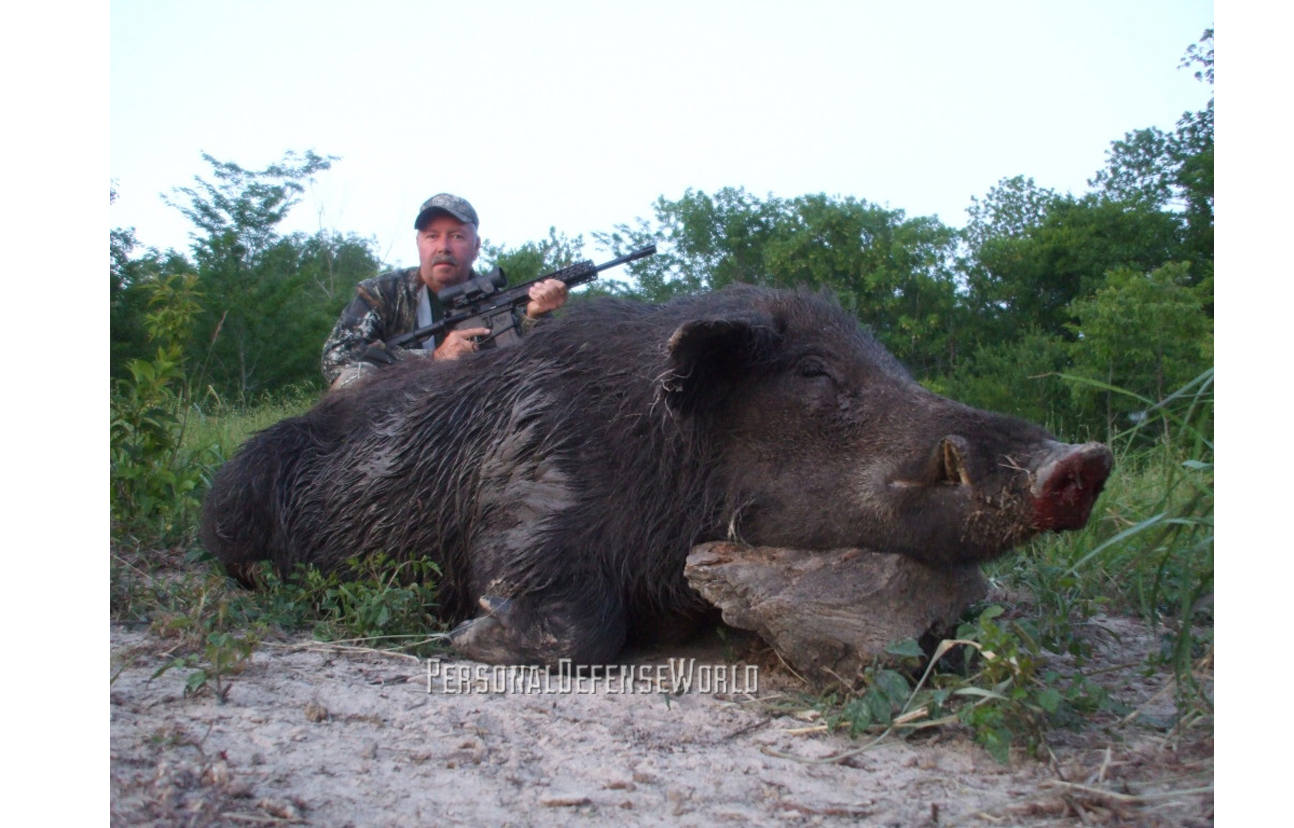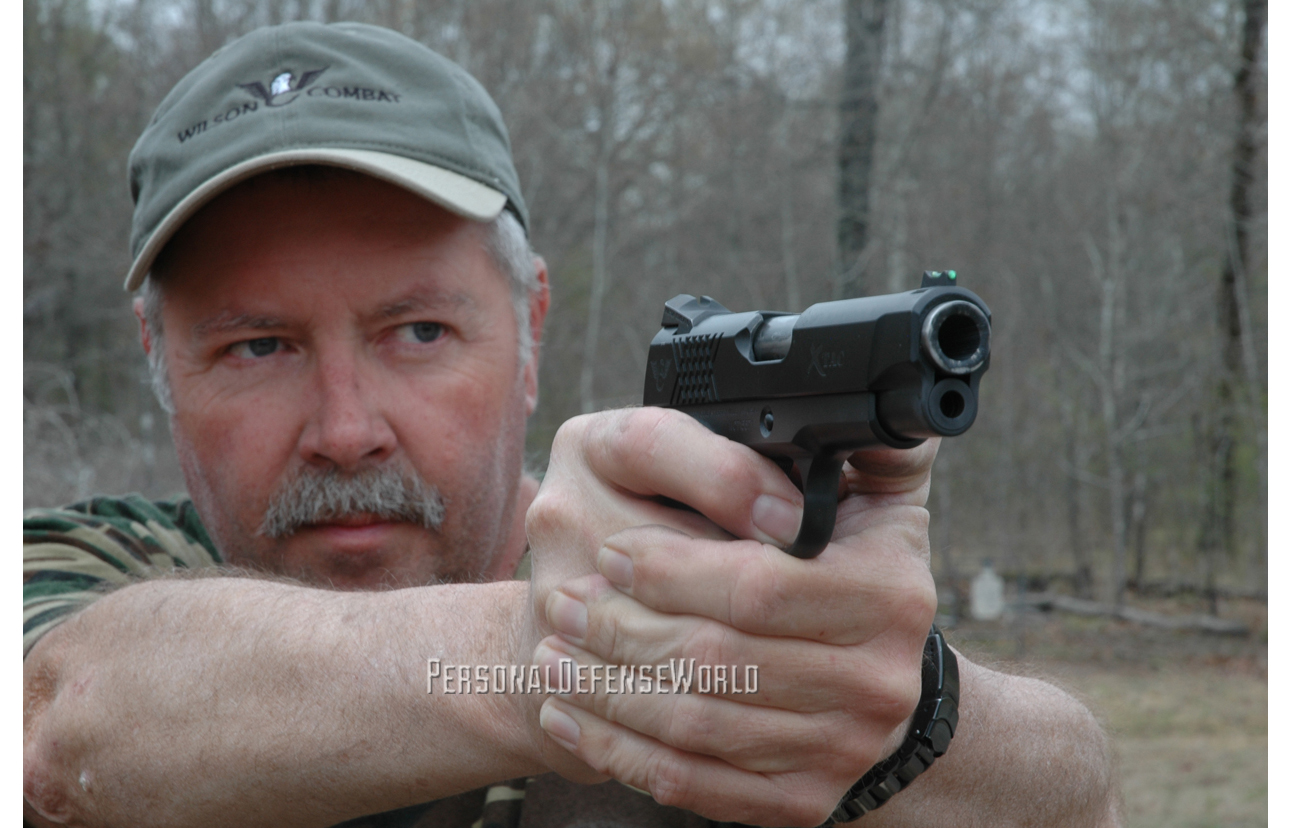The steel plates must have cringed. When Bill stepped to the line, they had to know bullets would follow. Lots of them. And fast.
Wilson drew the .45 ACP fluidly, as he had thousands of times before. The compact pistol emptied its magazine in quick-step, chattering without pause as it swept across the bank and back again. Every shot rang metal, the lead smears crowding each other.
I could have done the same. It just would have taken me six times longer.
Advertisement — Continue Reading Below
“Speed is easy. Accuracy is easy. Combining the two gives you fits,” smiled Bill. He knows. He’s been at it since 1976. That’s when he strapped on a Colt Python revolver to shoot a new kind of pistol match. That year, the Police Pistol Combat (PPC) competition shared the spotlight with the nascent International Practical Shooting Confederation (IPSC), which appeared after a conference of pistoleers in Columbia, Missouri. Using stopwatches to “factor” a score and a ballistic pendulum to keep power levels both reasonable and uniform, IPSC delighted shooters. It would soon spawn the United States Practical Shooting Association (USPSA). Bill Wilson threw his energy behind the movement as a volunteer—and threw his Python onto the shelf. “I could see right away I’d need an autoloader to compete.”
His first auto, a Browning Hi-Power, was soon replaced by a 1911. “But though I could hold my own with revolvers,” he says, “I had to relearn to shoot to shoot a .45 well.” The standard 1911 of the early ’70s gave him no help. Top shooters modified it extensively, changing sights, lowering the port, throating the barrel for 200-grain wadcutters. Triggers got attention, too. “By then, you’d invested hundreds.” Wilson started to work on his .45, then on others. His training as a jeweler (“My parents were in the business 50 years!”) may have helped him tune pistols. Along the way, he saw a promising market in 1911 parts. By 1978 he was tapping it, peddling triggers, sights and accessories. Two years later, Bill added magazines. Such was the start of what’s become a multi-million-dollar firm headquartered in Berryville, Arkansas. While Bill is still active in the business, he has turned daily operations over to his son, Ryan, who supervises 96 employees.
Bill and his wife, Joyce, a competitive shooter and an airplane pilot who flies cross-country Powder Puff races in her Cessna 182, now spend most of their time in rural Texas, short hours from the Wilson Combat plant. “We found this ranch in 2004, a couple of years after we’d built a new home in Arkansas,” says Bill. “We began improving it then.” That meant rifle and pistol ranges, a reloading facility, a lodge with a huge room to display Bill’s prodigious collection of big-game trophies and a stable for Joyce’s horses. The ranch has grown as Wilson added parcels. He has “excellent hog hunting” and, of course, deer and turkeys. Feeders and ponds make it a wildlife Mecca.
Advertisement — Continue Reading Below
High-End Pistols
Though a highly respected rifle-smith, Wilson is best known for his pistols. Still enamored of revolvers, he collects fine Colts while his shop turns out superb 1911s. You can order plenty of options, but Bill concedes an affinity for pistols “you might carry.” Invited to the 15th IPSC shoot after serving on the USPSA board for most of a decade, he recalls shooting a match dedicated to the “guns of 1976.” Subsequently, he and John Sayle helped launch the Limited Division in 1992. Later, Bill led a move within USPSA to form the International Defensive Pistol Association (IDPA). “It emphasizes practical handguns, even those you’d wear concealed,” he explains. The clean, Spartan profiles of many Wilson pistols reflect that focus as they show off the fine machining and exquisite fit and finish Bill demands.
Besides refining the iconic .45 ACP, Wilson has won accolades for mating it to the .38 Super cartridge. Remembered by some as a Depression-era solution to bulletproof vests on bootleggers, the .38 Super has an indisputable edge on the .45: it’s smaller. A standard 1911 magazine holds 10 .38s. The additional two or three rounds amounted to “high capacity” in 1986, when a Safariland poster showed Wilson, as a member of the USPSA team, firing a single-stack .38 Super. “The Super got a bad rap when the case headspaced on its modest rim. Headspaced on the mouth, it does just fine. The 9x21mm is essentially the .38 Super without a rim. Its base is the same as the 9mm’s.” Incidentally, as Bill dominated scoreboards with his .38, Brian Enos and Rob Leatham were also winning with Wilson pistols!
Wilson didn’t jump to follow the “high-cap” crowd in the early 1990s, staying with the single-stack design that had fueled his growing firm. “But we’re a custom shop,” he says. “We try to serve a variety of tastes. Our gunsmiths have the skill and equipment to build superior pistols, no matter what the need.”
Advertisement — Continue Reading Below
Going the Distance
Bill no longer fires 100,000 rounds a year in practice, but he’s still keen to produce cutting-edge 1911s. “We insist our 5-inch guns deliver 1-inch groups at 25 yards,” he tells me. The standard for 4-inch pistols: 1.5 inches. I fired both on his pistol range, at combat distances out to 100 yards. Clearly I’m no threat from the far end of a football field. But both Bill and his son, Ryan, stung the steel at long range. They fired off-hand and from behind a barricade, not from a bench. “A pistol should be easy to aim and fire, as it was meant to be aimed and fired,” maintains Bill.
Though he adores the .45 ACP, Bill parts company with shooters who deem the 9mm inadequate. “I’ve shot it enough to count on it in a carry gun,” he says. He favors the 115-grain Barnes XPB and the 124-grain Hornady XTP. “My load of Vihtavouri 3N37 kicks the Hornady out at 1,250 fps.” Like the .38 Super, the 9mm trumps the .45 in the recoil department. “You can shoot more often without flinching. In rapid-fire strings, you spend less time recovering from recoil.”
Wilson Combat catalogs both steel- and alloy-frame 1911s. “Steel is most popular, but I carry an alloy Compact,” Bill tells me, “Alloy frames should last 10,000 rounds. We’ve never had to replace one.”
Advertisement — Continue Reading Below
The Wilson line now includes four main versions of the 1911. Full-size pistols have the standard grip, slide and barrel measures of original 1911s, but you can add many refinements to your order. The Professional model has a 4-inch slide on a full-size frame. Compacts combine a trimmer grip with a 4-inch slide. The Sentinel is a subcompact, with a small slide and frame. All pistols come with a host of features and the attention to detail that have set Wilson Combat pistols apart since Bill Wilson began working on 1911s more than 30 years ago.
For More Information
Wilson Combat
800-955-4856
wilsoncombat.com
BUY NOW! www.personaldefenseworld.com/subscribe/combat-handguns.
Advertisement — Continue Reading Below


































